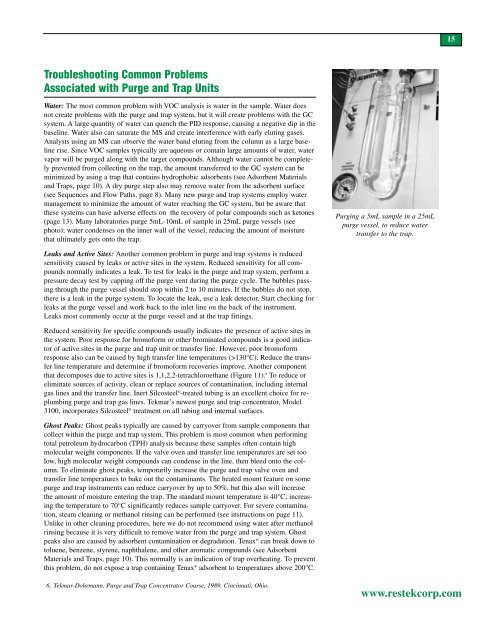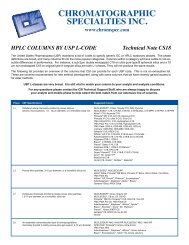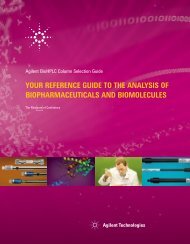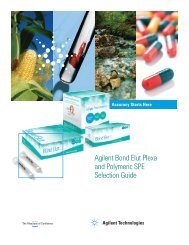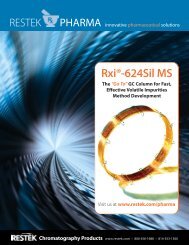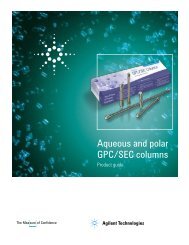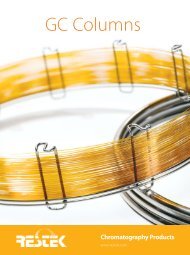Optimizing the Analysis of Volatile Organic Compounds
Optimizing the Analysis of Volatile Organic Compounds
Optimizing the Analysis of Volatile Organic Compounds
You also want an ePaper? Increase the reach of your titles
YUMPU automatically turns print PDFs into web optimized ePapers that Google loves.
Troubleshooting Common Problems<br />
Associated with Purge and Trap Units<br />
Water: The most common problem with VOC analysis is water in <strong>the</strong> sample. Water does<br />
not create problems with <strong>the</strong> purge and trap system, but it will create problems with <strong>the</strong> GC<br />
system. A large quantity <strong>of</strong> water can quench <strong>the</strong> PID response, causing a negative dip in <strong>the</strong><br />
baseline. Water also can saturate <strong>the</strong> MS and create interference with early eluting gases.<br />
Analysts using an MS can observe <strong>the</strong> water band eluting from <strong>the</strong> column as a large baseline<br />
rise. Since VOC samples typically are aqueous or contain large amounts <strong>of</strong> water, water<br />
vapor will be purged along with <strong>the</strong> target compounds. Although water cannot be completely<br />
prevented from collecting on <strong>the</strong> trap, <strong>the</strong> amount transferred to <strong>the</strong> GC system can be<br />
minimized by using a trap that contains hydrophobic adsorbents (see Adsorbent Materials<br />
and Traps, page 10). A dry purge step also may remove water from <strong>the</strong> adsorbent surface<br />
(see Sequences and Flow Paths, page 8). Many new purge and trap systems employ water<br />
management to minimize <strong>the</strong> amount <strong>of</strong> water reaching <strong>the</strong> GC system, but be aware that<br />
<strong>the</strong>se systems can have adverse effects on <strong>the</strong> recovery <strong>of</strong> polar compounds such as ketones<br />
(page 13). Many laboratories purge 5mL-10mL <strong>of</strong> sample in 25mL purge vessels (see<br />
photo); water condenses on <strong>the</strong> inner wall <strong>of</strong> <strong>the</strong> vessel, reducing <strong>the</strong> amount <strong>of</strong> moisture<br />
that ultimately gets onto <strong>the</strong> trap.<br />
Leaks and Active Sites: Ano<strong>the</strong>r common problem in purge and trap systems is reduced<br />
sensitivity caused by leaks or active sites in <strong>the</strong> system. Reduced sensitivity for all compounds<br />
normally indicates a leak. To test for leaks in <strong>the</strong> purge and trap system, perform a<br />
pressure decay test by capping <strong>of</strong>f <strong>the</strong> purge vent during <strong>the</strong> purge cycle. The bubbles passing<br />
through <strong>the</strong> purge vessel should stop within 2 to 10 minutes. If <strong>the</strong> bubbles do not stop,<br />
<strong>the</strong>re is a leak in <strong>the</strong> purge system. To locate <strong>the</strong> leak, use a leak detector. Start checking for<br />
leaks at <strong>the</strong> purge vessel and work back to <strong>the</strong> inlet line on <strong>the</strong> back <strong>of</strong> <strong>the</strong> instrument.<br />
Leaks most commonly occur at <strong>the</strong> purge vessel and at <strong>the</strong> trap fittings.<br />
Reduced sensitivity for specific compounds usually indicates <strong>the</strong> presence <strong>of</strong> active sites in<br />
<strong>the</strong> system. Poor response for brom<strong>of</strong>orm or o<strong>the</strong>r brominated compounds is a good indicator<br />
<strong>of</strong> active sites in <strong>the</strong> purge and trap unit or transfer line. However, poor brom<strong>of</strong>orm<br />
response also can be caused by high transfer line temperatures (>130°C). Reduce <strong>the</strong> transfer<br />
line temperature and determine if brom<strong>of</strong>orm recoveries improve. Ano<strong>the</strong>r component<br />
that decomposes due to active sites is 1,1,2,2-tetrachloroethane (Figure 11). 6 To reduce or<br />
eliminate sources <strong>of</strong> activity, clean or replace sources <strong>of</strong> contamination, including internal<br />
gas lines and <strong>the</strong> transfer line. Inert Silcosteel ® -treated tubing is an excellent choice for replumbing<br />
purge and trap gas lines. Tekmar’s newest purge and trap concentrator, Model<br />
3100, incorporates Silcosteel ® treatment on all tubing and internal surfaces.<br />
Ghost Peaks: Ghost peaks typically are caused by carryover from sample components that<br />
collect within <strong>the</strong> purge and trap system. This problem is most common when performing<br />
total petroleum hydrocarbon (TPH) analysis because <strong>the</strong>se samples <strong>of</strong>ten contain high<br />
molecular weight components. If <strong>the</strong> valve oven and transfer line temperatures are set too<br />
low, high molecular weight compounds can condense in <strong>the</strong> line, <strong>the</strong>n bleed onto <strong>the</strong> column.<br />
To eliminate ghost peaks, temporarily increase <strong>the</strong> purge and trap valve oven and<br />
transfer line temperatures to bake out <strong>the</strong> contaminants. The heated mount feature on some<br />
purge and trap instruments can reduce carryover by up to 50%, but this also will increase<br />
<strong>the</strong> amount <strong>of</strong> moisture entering <strong>the</strong> trap. The standard mount temperature is 40°C; increasing<br />
<strong>the</strong> temperature to 70°C significantly reduces sample carryover. For severe contamination,<br />
steam cleaning or methanol rinsing can be performed (see instructions on page 11).<br />
Unlike in o<strong>the</strong>r cleaning procedures, here we do not recommend using water after methanol<br />
rinsing because it is very difficult to remove water from <strong>the</strong> purge and trap system. Ghost<br />
peaks also are caused by adsorbent contamination or degradation. Tenax ® can break down to<br />
toluene, benzene, styrene, naphthalene, and o<strong>the</strong>r aromatic compounds (see Adsorbent<br />
Materials and Traps, page 10). This normally is an indication <strong>of</strong> trap overheating. To prevent<br />
this problem, do not expose a trap containing Tenax ® adsorbent to temperatures above 200°C.<br />
6. Tekmar-Dohrmann, Purge and Trap Concentrator Course, 1989. Cincinnati, Ohio.<br />
Purging a 5mL sample in a 25mL<br />
purge vessel, to reduce water<br />
transfer to <strong>the</strong> trap.<br />
15<br />
www.restekcorp.com


